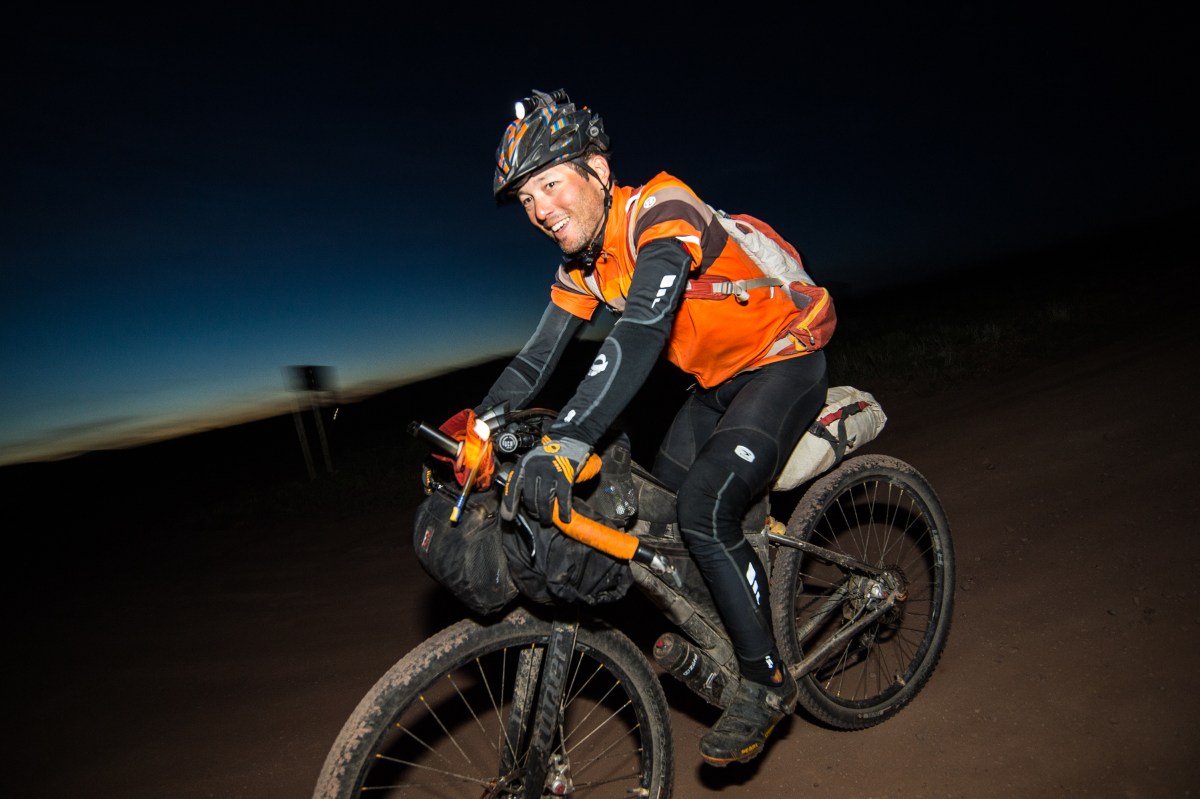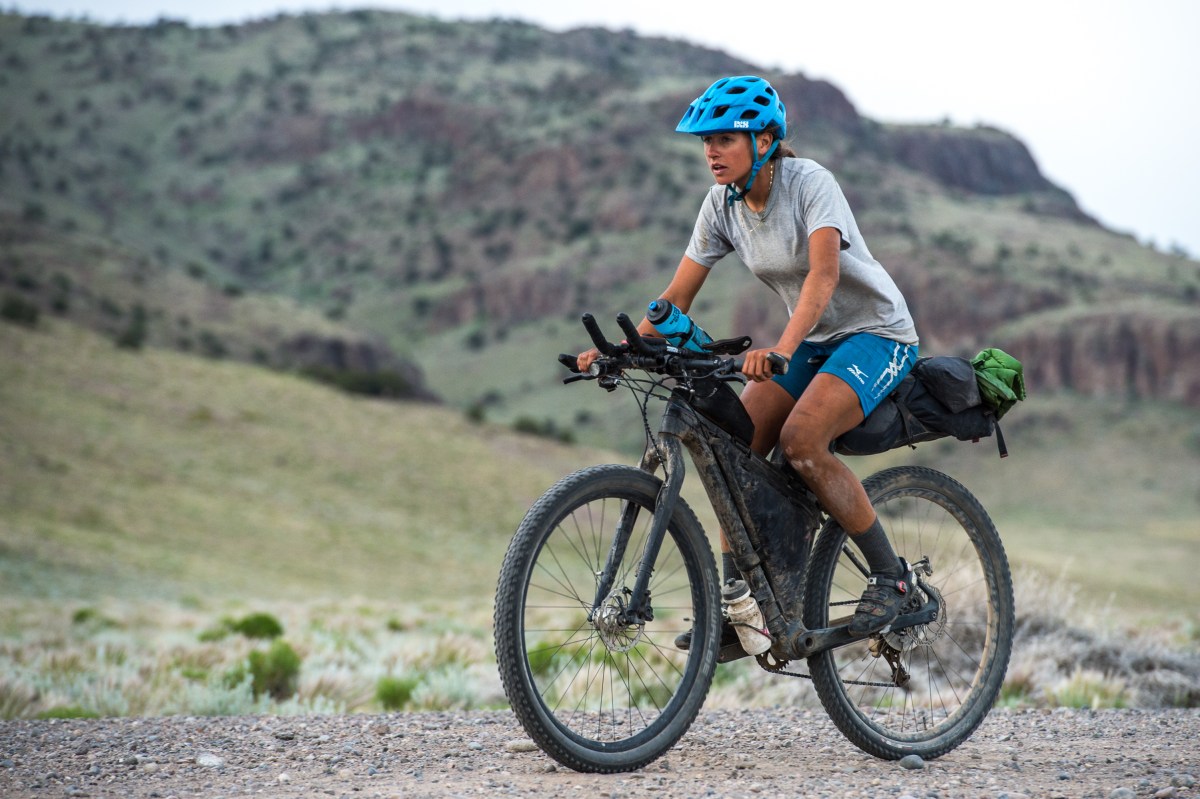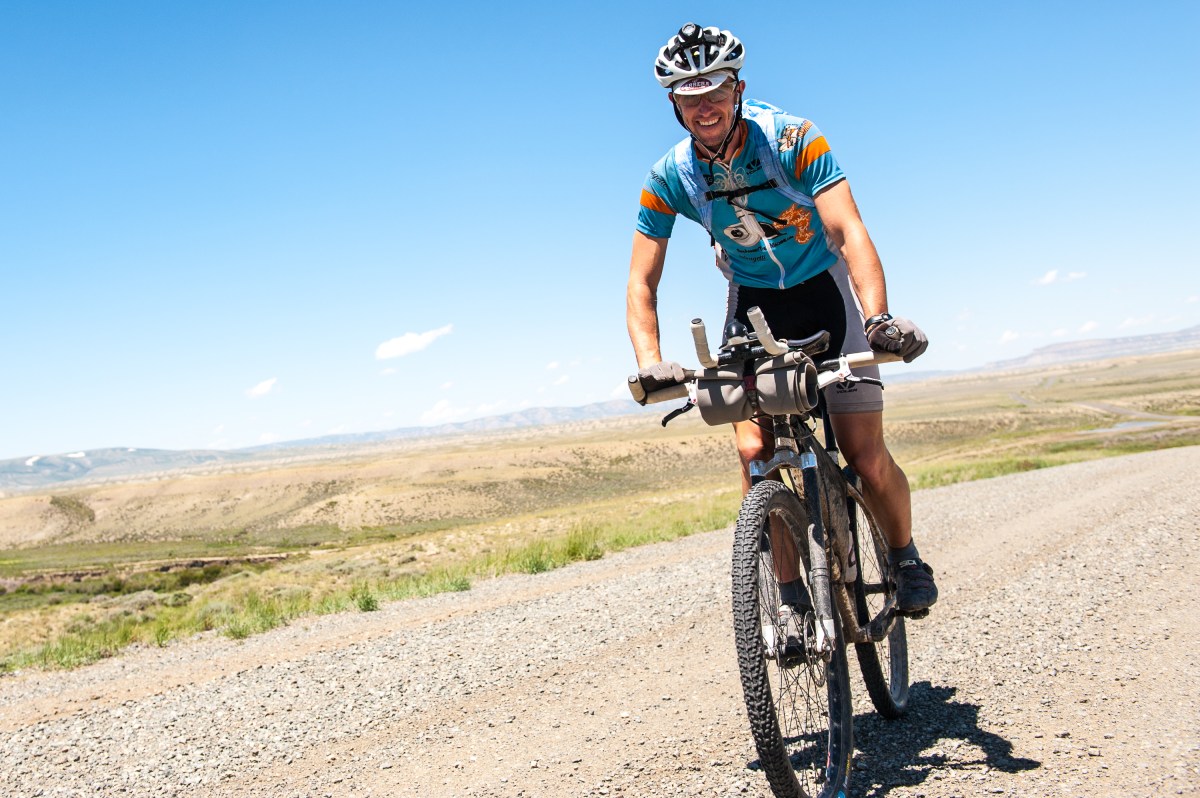On the second Friday in June, cyclists from around the world will gather at the Fairmont Banff Springs Hotel in Banff National Park, Alberta, Canada, for the 12th annual Grand Départ of the Tour Divide. Considered one of the original and most important races in ultra-endurance bikepacking, the Tour Divide is a competition for the fastest time on the Great Divide Mountain Bike Route (GDMBR). This route is almost entirely off-pavement, starting in Banff, zigzagging for 2,745 miles along the Continental Divide, and finishing in Antelope Wells, New Mexico, on the border between the United States and Mexico. The Great Divide route was designed by Mac McCoy and established by the Adventure Cycling Association in 1998. When cyclists arrive at the end, they will have climbed more than 200,000 feet in elevation.
The Tour Divide is an ode to the spirit of self-supported adventure. There are no aid stations, prizes or entry fees. Competitors need only write a letter of intent to register for the race. Once the clock starts, the rider embarks on a solo, unsupported journey to get to the finish line. The race was conceived in 2004 by cyclist Mike Curiak. It was originally called the Great Divide Race and followed a slightly shorter course along the original Great Divide Mountain Bike Route, starting in Roosville, Montana, at the Canadian border. When Adventure Cycling added a 221-mile section in Canada, frontrunner Matthew Lee amended the race in 2008 to start in Banff and renamed it the Tour Divide. In 2016, Mike Hall set the current record for time, winning the Tour Divide in 13 days, 22 hours and 51 minutes. (Hall passed away in 2017 when he was struck by a motorist while riding his bike in the Indian Pacific Wheel Race in Australia.)
For several weeks, the fastest racers keep a pace of between 150 to 200 miles per day and sleep an average of four hours per night. The confluence of sleep deprivation, physical exhaustion, soul-searching solitude and capricious weather leads many racers to drop. Just finishing—let alone winning—the Tour Divide is testament to a racer’s ability to endure physically and mentally. These are six Tour Divide racers who have persevered.
John Stamstad
Age: 54
Hometown: Seattle, Washington
Professional mountain biker John Stamstad was known for competing in the toughest bike races in the world—he won the Iditasport eight times, consecutively, from 1993 to 2000. When he turned to the Great Divide in August 1999, he said his intention was to ride the route as fast as possible and set the first speed record. Stamstad’s attempt was before the Tour Divide existed. He lined up a full support team to follow him. But the week before his departure, he changed his approach.
“When you do something for the first time, you set an important precedent for how other folks are going to do it, and I thought that [riding supported] was the wrong message,” he said. “I thought it would be better to do as a self-supported, solo, bikepacking adventure, making use of anything you could find along the route.”
With Adventure Cycling maps and a compass to guide his way, Stamstad headed south, solo. Elevation gain had not been calculated at the time, so he didn’t know how much climbing lay in store, nor where surface water could be found, nor how his body would perform with lack of sleep. He carried too much water, ate too much candy, made wrong turns and climbed up wrong passes, and finished 18 days and five hours later. When he got to the southern terminus, the border control agent on duty gave Stamstad tomatoes from his garden—his first fresh food in two and a half weeks. And that was it.
“Nobody cared and nobody knew and rightfully so,” he said, of that first record. “Nowadays there are [bikepacking] races all over the world, more than you could probably do in a career, and I think that’s pretty awesome.”
Stamstad has not ridden the Great Divide Mountain Bike Route since, and he never competed in the Tour Divide. However, the bikepacking community credits Stamstad’s ride as the first independent time trial (or ITT) of the Tour Divide (racers who cannot participate in the Grand Départ can still compete for Tour Divide records utilizing a SPOT or GPS tracker). He also established the self-supported ethos Tour Divide racers abide by today.

Riders: Tracey and Jay Petervary | Photo Credit: Eddie Clark
Tracey and Jay Petervary
Ages: 47
Hometown: Victor, Idaho
In 2009, Tracey and Jay Petervary raced the Tour Divide on a tandem bicycle they named the Love Shack.
A married couple from Victor, Idaho, the Petervarys are seasoned endurance competitors. They competed throughout their 20s in international adventure events like the Eco-Challenge and dabbled in mountain biking and ultrarunning before finding their community in endurance cycling.
In 2007, Jay raced the Great Divide Race—the early iteration of the Tour Divide—and beat Mike Curiak’s record by a day, finishing in 15 days, 4 hours and 18 minutes. “I found something that I truly loved,” he said. “I never had such a fun time during an event. I called it the Ice Cream and Hamburger Tour because that’s what you did. You just ate and rode your bike all day.”
Jay wanted to share that experience with Tracey—quite literally. They arrived at the start line in 2009 with a custom-built tandem. For two weeks straight, they rode in the rain. The steel tandem was more than 55 pounds fully loaded, punishingly slow on the climbs and borderline out-of-control fast on the descents.
“When we were close to running out of food, Jay looked like he was going to eat me, he just looked so rabid,” said Tracey. “Also, because I was in the back, I was dealing with a lot of farting. Eventually I was like, no more ice cream.”
The couple finished in 18 days, 13 hours and 50 minutes, setting the first fastest known tandem time, a record that has yet to be bested.
Both Jay and Tracey have returned to the Tour Divide separately. Tracey finished solo at the 2011 Tour Divide, despite a bout of food poisoning. Jay completed three ITTs, setting a record during his 2012 ride, and another Grand Départ in 2015.

Rider: Josh Kato | Photo Credit: Eddie Clark
Josh Kato
Age: 44
Hometown: Cashmere, Washington
In 2014, Josh Kato and his wife, Valerie, arrived in Banff with the goal to simply finish the Tour Divide (on separate bikes). That year, Valerie finished, but Josh said he was forced to drop out after 1,000 miles, when a crash severely injured his hamstring and fractured his fibula.
Kato returned the following year and won, ousting elite endurance riders Jay Petervary and Neil Beltchenko in a sprint across the final 110 miles before the U.S.-Mexico border. The three finished within the same hour and Kato laid down a new record, completing the Tour Divide in 14 days, 11 hours and 37 minutes.
But he still wasn’t done with the Tour Divide.
“It’s the pinnacle of bike racing,” said Kato. “It’s just you, the bike, and the course. You can learn a lot about yourself if you’re open to it. There is something special about the Divide and that’s why I keep coming back.”
He was back at the starting line in 2016. Just 700 miles into the race, a driver ran Kato off-road. He tumbled down a rocky embankment and suffered soft tissue and ligament damage in his leg. He dropped out, again, bitterly following the race as Mike Hall set the speed record that still stands today.
When Kato arrived in Banff in 2017 to race the Tour Divide yet again, he was nearly 20 pounds heavier and had done little conditioning on the bike. Over the next 15 days, he ran out of food and water multiple times. Whether from severe dehydration or heat exposure, Kato eventually started hallucinating. A registered nurse, he envisioned he was riding his bike down a hospital hallway with rocks and trees turning into dying patients by his side. Haunted by his 2016 Tour Divide, he imagined large animals morphing into cars to try to run him over.
Paranoid, Kato said he hurried out of every town he passed through and often neglected to properly resupply, which only compounded the issues stemming from his chronic malnutrition and dehydration. In southern Colorado, he recognized the beginnings of a gastrointestinal bleed. Still, he pedaled on. He was often confused, once riding back and forth along the route for an hour, unsure of which direction he was heading, or where he was, or what he was doing. In New Mexico, he woke up laying in a ditch with no recollection of how he got there.
By sheer willpower, Kato finished the 2017 race in second place. He took 2018 off, watching the Tour Divide from the sidelines, but he will be in Banff again this year, ready to take on whatever the course throws his way.

Rider: Lael Wilcox | Photo Credit: Eddie Clark
Lael Wilcox
Age: 32
Hometown: Anchorage, Alaska
At the age of 28, Lael Wilcox was still making a name for herself in bikepacking when, in 2015, she raced the Great Divide twice—first during the Tour Divide, setting the women’s record. And again, two weeks later, when she re-visited the route to beat her own record.
As prologues for both of her rides, Wilcox rode her bike to the start line in Banff. Before the Grand Départ, she logged 2,100 miles of vast highway from Anchorage to Banff, to prepare herself physically, mentally and emotionally. She finished the Tour Divide in 17 days, 1 hour and 51 minutes—taking four days off of the previous women’s record—despite a case of bronchitis that forced her off-route to the closest urgent care.
Wilcox said she was tormented by the thought that she could have ridden faster had she not been sick. So two weeks later, she took a ferry from Anchorage to Bellingham, Washington, and again rode to Banff—this time only 800 miles. On her second ride down the Great Divide, she shaved two days off of her previous time, setting the current women’s record at 15 days, 10 hours and 59 minutes.
Wilcox is returning to Banff again this year—by car, not bike. She will be fresh off of a 650-mile prologue tour from Boulder, Colorado, to Emporia, Kansas, and the 350-mile Unbound Gravel XL race, where she came in sixth overall and was the first woman finisher. She has her eyes on breaking the men’s record, but with massive spring snowfall in the Rockies, Wilcox thinks times will probably be slower than in years past. Still, she’d like to win the Tour Divide outright.
“You never know what you’re capable of until you try it,” she said. “I’m not going to end up in a race with the fastest road racers in the world, but I can start at the Tour Divide with people considered the fastest endurance racers and try to beat them. I love how it’s an equal playing field for that [competition].”

Rider: Chris Plesko | Photo Credit: Eddie Clark
Chris Plesko
Age: 37
Hometown: Denver, Colorado
A middle school math teacher by profession, single-speeder Chris Plesko knows that to do well on a test, you have to prepare. Yet Plesko was hardly prepared for his first attempt on the Tour Divide. In 2008, he set out on a single-speed for a southbound ITT with no sleeping bag and little idea of the challenges that lay ahead. Less than halfway through, he dropped out.
For the next 12 months, Plesko dedicated himself to getting stronger. When he rode out of Banff with the Grand Départ in 2009, he carried a sleeping bag and a firm resolve to set the single-speed record, which he did, finishing in 19 days and 21 minutes despite immense amounts of rain and tire-sucking mud.
After that experience on the Tour Divide, Plesko said he didn’t ride a bike again for four years. But then he followed the showdown between Petervary, Kato and Beltchenko in the 2015 Tour Divide—and their sprint to the finish—and Plesko knew he wanted in on the Tour Divide again.
“I can literally picture in my head exactly where [Kato] pulled away from them,” he said. “Watching them battle it out on the last day after 14 days of racing, that’s what hooked me back in. It was so powerful.”
In 2016, he was back for the Grand Départ. He had trained with a coach for two years, and this time, he beat his single-speed record by four days—finishing in 15 days, 8 hours and 1 minute. He paid dearly for his new course record. Badly sunburned and physically wasted, Plesko said he lost 15 pounds in those two weeks.
Plesko plans to make one more go of the Tour Divide in the not-too-distant future with the dream of finishing first overall on a single-speed bike.
“Yeah you’re racing, but at the end of the day, it’s this personal journey and challenge,” he said. “That’s what draws a lot of people into doing these events. It’s something different. Daily life is not so hard when you’ve dealt with it on a bike out in the middle of nowhere.”
